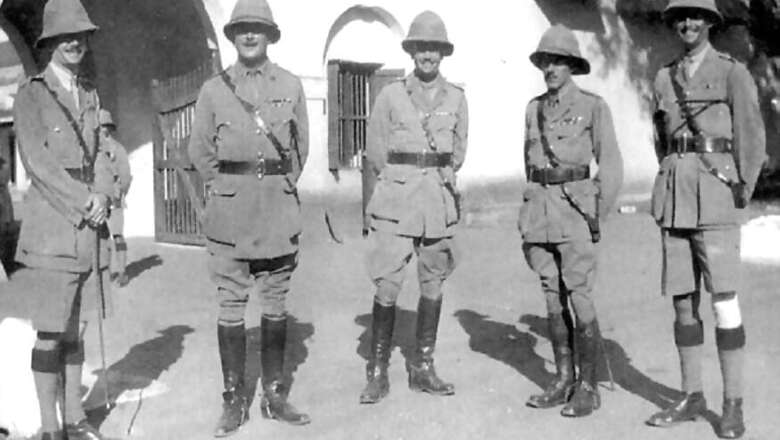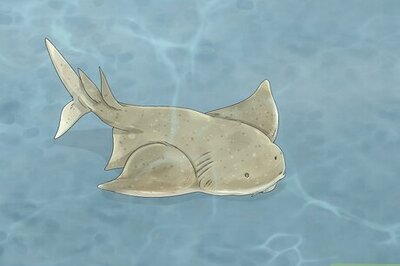
views
The Khilafat Movement was punctuated by numerous incidents of violence. A grossly under-estimated list of Muslim rioting from 1919-1922 during the Khilafat Movement is as follows (Gandhi and Anarchy, Sir C. Sankaran Nair, Tagore & Co. Madras, 1922, pp. 250, 251): Nellore (22 September 1919), Muthupet, Tanjore (May 1920), Madras (May 1920), Sukkur, Sind (29 May 1920), Kachagarhi, NWFP (8 July 1920), Kasur, Punjab (25 August 1920), Pilibhit, U.P. (23 September 1920), Kolaba Dist. Bombay (9 January 1921), Naihati, Bengal (4, 5 February 1921), Karachi (1 August 1921), Madras (5 October 1921), Calcutta (24 October 1921), Howrah (4 November 1921), Coorg (17 November 1921), Cannanore (4 December 1921), Jamumamukh, Assam (15 February 1922), Sylhet (16 February 1922).
What stands out however in terms of sheer scale and ferocity was the Moplah rebellion (1921-22). The Moplah or Malabar rebellion has been variously described as a nationalist uprising against British authorities and their Hindu allies or a Muslim peasant uprising against Hindu landlords. Communist stalwart E.M.S Namboodiripad opined that “It is to the illiterate backward Moplah of the Ernad and Walluvanad taluks that the honour goes of having raised the initial voice of protest against the oppression of the janmi” (janmi or holder of the janam or birthright or exclusive usufruct of the soil; A Short History of Peasant Movement in Kerala, E.M.S. Namboodiripad, People’s Publishing House, Bombay, 1943. p.1). Indeed, the Freedom Fighters & Rehabilitation Division under the Ministry of Home Affairs, Government of India recognizes both the Khilafat Movement and the ‘Moplah Uprising’ for purposes of freedom fighters’ pension scheme.
To stay away from bias, we shall lean heavily on The Moplah Rebellion, 1921 by Diwan Bahadur C. Gopalan Nalr, Retired Deputy Collector, Calicut, Norman Printing Bureau, 1923 which is a bald chronicle of events based on the articles and news in the Madras Mail and the West Coast Spectator newspapers compiled within two years from the actual events.
The land and its people
The name Mappilla (lit. son-in-law; anglicized form Moplah) is given to Malayali-speaking Muslims who reside along the entire length of the Malabar Coast of northern Kerala. By 1921, the Moplahs formed the largest and fastest growing community in Malabar. With a population of one million, 32 percent of that of Malabar as a whole, the Moplahs were concentrated in South Malabar. In Ernad taluk, the centre of the rebellion, they constituted 60 percent of the population (The Mappilla Rebellion, 1921: Peasant Revolt in Malabar, Robert L. Hardgrave, Jr., Modern Asian Studies, Vol. 11, No. 1, 1977, p. 58).
Though the then Malabar district consisted of ten taluks, Martial Law was proclaimed in Ernad, Walluvanad, Ponnani, Calicut of South Malabar and Kurumbranad and Wynad of North Malabar. The Muslims gained a footing in Malabar for commercial purposes, and the Cheraman Perumal (lit. Chera king) was persuaded by them to embrace Islam. In August 825, Cheraman sailed for Mecca. He asked Arab missionaries to proceed to Malabar and propagate Islam. A party of 15, with, Malik-lbn-Dinar as their leader landed at Kodungallur. After obtaining permission from the rulers of the country, they built ten mosques in Malabar and South Canara and commenced a career of proselytism, which resulted in the creation of Moplahs.
The Zamorin of Calicut encouraged conversion in order to man the Arab Ships and decreed that in every family of fishermen, at least one male member should be brought up as a Muhammadan (District Gazetteer). Forcible conversions occurred during the campaign of Tipu Sultan in August 1789 (Nair, ibid, pp.3, 4).
The Moplahs of North Malabar were converted from among the propertied classes of the higher castes whereas those of South Malabar were principally from lower Tiyya, Cheruman and Mukkuvan castes (Hardgrave, ibid, p. 59).
Past Moplah Attacks
Moplah outrages have been documented from 1742 onwards. The earliest striking attack was carried out by two Moors (Moplahs) on a Portuguese church in Darmapatam (Dharmadam) Fort near Thalaserry in March 1764. The explanation for these and subsequent outrages is found in the sixteenth century Arabic history of Malabar by Zayn al-din al-Ma’bari entitled the Tuhfat al-Mujahidin fi ba’d ahwal al-Purtukaliyyin (A Gift to the Holy Warriors in respect to some Deeds of the Portuguese) that was completed sometime in the 1580s.
The book was written to encourage Muslims to undertake jihad against the Portuguese. It is however, noteworthy that pan-Islamic feeling among the Moplahs has been dated at least to the sixteenth century when they are known to have fought with the Atjehnese Muslims of Indonesia against the Portuguese (The Islamic Frontier in Southwest India: The Shahīd as a Cultural Ideal among the Mappillas of Malabar, Stephen F. Dale, Modern Asian Studies, Vol. 11, No. 1, 1977, pp. 42-43, 48, 52).
An analysis of these outbreaks has been done by Stephen Dale (The Mappilla Outbreaks: Ideology and Social Conflict in Nineteenth-Century Kerala, The Journal of Asian Studies Vol. 35, No. 1, Nov. 1975, pp. 85-97). There were approximately thirty-three Moplah outbreaks recorded in Malabar District between 1836 and the Moplah rebellion of 1921-22 with more than half of them in the first sixteen years of this period.
Nearly all of the outbreaks occurred in rural areas, and all but one were confined to the territory between Calicut and Ponnani, a town about thirty-five miles to the south. Except three, these outbreaks involved attacks by Moplahs on Hindus. These disturbances were very minor, suppressed within a few days, involved few victims and only three times did more than thirty Moplahs participate in an attack. All but a few cases were climaxed by the virtual suicide of all the Moplahs involved, in an attempt to become shahid (martyrs for the Faith). Of the 350 Moplahs directly involved in the attack, 322 died and only 28 survived to be captured. The rituals leading to the final suicidal attack started several weeks before the actual attack.
Of the 33 incidents, nine were clearly rooted in rural class conflict; three other incidents were partially shaped by agrarian grievances. But there were thirteen other relatively well-documented incidents that had no obvious connection with agrarian disputes. Four of these resulted from personal quarrels. Two were attacks on British collectors – on one because he had exiled a Muslim religious leader and on the other because he had rescued a Hindu boy who had been forcibly converted to Islam. In three cases, Hindus and their families had been killed because they had apostatized from Islam. Finally, in eight cases, it is impossible to guess the motives of the assailants. Religious leaders such as Sayyid Fazl (c. 1820-1901) who preached jihad were the single determinant of the Moplah outbreaks. These leaders were of two types – Thangals who were usually Arabs and acted as qazis and imams of the more important mosques and mussaliars who were generally less educated and acted as mullas qualified to interpret the Quran.
Economic reasons cannot explain the past Moplah outbreaks. Eviction from the land was a major agrarian grievance. However, there was no significant sustained rural violence among the various Hindu agricultural castes who actually suffered two-thirds of all evictions from 1862-1880. Secondly, Moplah outbreaks did not increase with the rise in eviction decrees. Quite the contrary, there were only three incidents in the eighteen year period from 1862-1880 when eviction decrees rose dramatically from 1,891 to 8,335. Finally, all but one of the outbreaks erupted within a very small area of the southern taluks though there were Moplahs resident in every taluk of the District.
The major difference between the outbreaks and the 1921-22 rebellion is that in 1921, the Khilafat Movement added the crucial elements of ideology and organization to the pre-existing traditions of religious militancy and social conflict.
Seeds of Moplah Violence
The Khilafat movement was introduced into Malabar district on 28 April 1920 by a resolution at the Malabar District Conference, held at Manjeri in Ernad Taluk. The Conference, attended by around 1,000 delegates, mostly Moplahs, urged the government to settle the Turkish question, failing which, it called “upon the people to adopt a policy of progressive Non-cooperation with the Government, as resolved by the Khilafat Conference held at Madras under the presidency of Maulana Shaukat Ali” (Nair, ibid, p. 8).
Gandhi and Shaukat Ali visited Calicut on 18 August, 1920, and their speeches on Khilafat and Non-cooperation led to the establishment of Khilafat Committees in Malabar. Several comparatively larger Khilafat meetings had been held at prominent Moplah centres during the few months immediately prior to the violence. (Nair, ibid, pp. 8-10).
When Yakub Hasan, a Khilafat leader of Madras visited Calicut on 15 February 1921 for the purpose of addressing Khilafat and Non-cooperation meetings he was served with prohibitory orders. This created severe resentments among the Moplahs (Nair, ibid, pp. 12, 15-16). Itinerant preachers wandered over the countryside, spreading Khilafat propaganda, and rumours circulated widely that the Afghans were on their way. In anticipation of Swaraj, Khilafat leaders had allegedly already parcelled out the land to poor Moplahs and were only awaiting the movement to take actual possession. A speech made by Maulana Muhammad Ali in Madras was circulated in pamphlet form in Malabar and proscribed by district authorities (Hardgrave, ibid, p. 71).
Logistic factors conducive to Violence
Every Moplah centre had a Khilafat association, with a Moplah president, a Moplah secretary and a majority of Moplah members. The number of such Khilafat committees is not known, but it is estimated that ‘there may have been as many’ as 100 Khilafat Committees formed in the two taluks of Ernad and Ponnani” (Nair, ibid, p. 16, 18). Every village had its own Khilafat association, and there was a regular system of inter-communication between villages, whereby men from a considerable area could be rapidly summoned to any point. The congregational form of worship centred in the mosque drew Muslim settlement patterns into a nucleated form in contrast to the more dispersed pattern characteristic of Hindu Malabar (Hardgrave, ibid, p. 72).
R.H.Hitchcock, District Superintendant of Police opined, “Far more important than the network of the Khilafat movement, however, was the traditional system of communication among the Mapillas, something which constituted a major difference between the Hindu and Mappilla. The few bazaars that exist are entirely Mappilla and most Mappillas do congregate at least once a week for Friday prayers and often at other times in Mosques. They can therefore form some kind of a public opinion of their own and combine but the fact that this is done under the cover of religion makes it difficult for Hindu or European even to become aware of it. Except at very occasional festivals the Hindus have no such opportunity of meeting (A History of the Malabar Rebellion, R.H. Hitchcock, Government Press, Madras, 1921, p.3).
The Moplahs had armed themselves with a variety of weapons. These included swords about two feet long with horned handles, both single and double edged, pointed at the top; big shikar knives about one and a half feet long; ordinary Moplah knives, pig spears cut in the middle about three feet in length; lathis; Mammuthi and axe handles (The Mapilla Rebellion 1921-1922, G.R.F. Tottenham, Government Press, Madras, 1922, p. 36).
The enclosed nature of the Malabar country, especially the hilly interiors made the task of rounding up the rebels difficult. They would split up into different gangs and adopt guerilla methods of warfare, and… presented a military problem of no little difficulty (Tottenham, ibid, p. 38).
The local police, many of them Moplahs, proved utterly inadequate to coping with the situation. Police stations were raided; there was practically no resistance and all arms were taken away by rebels (Nair, ibid, p. 71; also Tottenham, ibid, p. 7).
Lastly, but importantly, the Hindus were lulled by mindless slogans of Hindu-Muslim unity. As Tottenham writes, “In the Mahatma’s Hindu sheath of non-violence rattled the violent sword of Islam audibly. The Mapilla…went home and began to think of forging his plough-share into the sword, his saw into many war-knives. Non-violence was only the cover, to be cast away when the moment for action came…the young Hindu orators, blissfully unaware of the Mapilla mentality, went on with their campaign…” (Tottenham, ibid, p. 3).
First, the cold statistics. The violence broke out on 20 August 1921. Martial Law was promulgated on 26 August and withdrawn on 25 February 1922. The violence may be finally said to have ended on 30 June 1922 when Abu Bakr Musaliyar, the last remaining Moplah leader was captured. It was at its height from September to December 1921. In reply to a question in the Central Legislature (Debates; 16 January 1922), Home Secretary Sir William Vincent replied "The Madras Government report that the number of forcible conversions probably runs to thousands but that for obvious reasons it will never be possible to obtain anything like an accurate estimate” (Pakistan or the Partition of India, B.R. Ambedkar, Thacker and Company Limited, 1945, p. 148).
A total of 20,800 Hindus were killed and more than 4000 Hindus became Muslim at the point of sword. Lakhs of Hindus were rendered homeless. Around 2,339 Moplahs were killed and 1,652 Moplahs were injured due to British bullets. Cases were foisted on 39,338 rebels and 24,167 were prosecuted (Maharashtra Hindusabhechya karyacha itihas, Marathi, S.R. Date, Pune, 1975, pp.21, 22). The number of temples destroyed or desecrated exceeded 1000 (Nair, ibid, p.88).
The armed reserve of Calicut and Malappuram at the beginning of the outbreak was 210 strong. During the violence, the force known as Malabar Special Police was raised in the District and eventually reached a strength of 600 (Nair, ibid, p. 39). The toll of Military and Malabar Special Police was 43 killed and 126 wounded; of District Police and Reserve Police the toll was a further 24 killed and 29 wounded (Tottenham, ibid, p. 48, 53, 414, 425).
A number of Muslim leaders installed themselves as Khilafat kings or governors and supervised the violence of Hindus. Ali Musaliar, Variankunnath Kunhammad Haji Raja and C.I. Koya Thangal are such examples. The last named held his court on the slope of a bare hillock with about 4,000 followers from the neighbouring villages. More than 40 Hindus were taken to the Thangal with their hands tied behind their back, charged with the crime of helping the Military and 38 of these Hindus were condemned to death. He supervised the work of murder in person and seated on a rock near a well witnessed his men cutting at the neck of his victims and pushing the bodies into the well (Nair, ibid, pp. 76-80). Interestingly, this was copy- cat killing, similar to that of the Jewish tribe of Banu Qurayza in the Battle of the Trench in 627 CE by the Islamic forces led by the Prophet.
Secularist hoax
Secularist narrative on the Moplah rebellion that justifies rape and murder by ascribing secular motivations deserves to be scrutinized. As early as 1852, T.L. Strange who was appointed as Special Commissioner in Malabar to enquire into the causes of the Moplah outrages wrote in his report, “I …am convinced that though instances may and do arise of individual hardship to a tenant, the general character of the dealings of the Hindu landlords towards their tenantry, whether Moplah or Hindu, is mild, equitable and forbearing... the Moplah tenantry, especially of the Taluks in South Malabar, where the outbreaks have been so common, are very prone to evade their obligations and to resort to false and litigious pleas… The Hindus, in the parts where 'the outbreaks have been most frequent, stand in such fear of the Moplahs as mostly not to dare to press for their rights against them, and there is many a Moplah tenant who does not pay his rent, and cannot, so imminent are the risks, be evicted’ (Nair, ibid, p.6).
In the run-up to the violence, several incidents of Moplahs attacking the lower caste Tiyyas occurred over the picketing of toddy-shops, a part of the Non-cooperation campaign that particularly appealed to Muslim sentiment (Hardgrave, ibid, pp. 70, 71).
If indeed the violence was an anti-colonial or proletarian enterprise, why were Hindus converted and temples destroyed while mosques remained intact? There is no record of the murderers themselves giving a secular gloss to their Islamic motivations. In their own way, two outstanding leaders ascribed not secular but strictly Islamic motivations to the actions of the Moplahs.
Gandhi spoke of the Moplahs as “brave God-fearing Moplahs who were fighting for what they consider as religion and in a manner which they consider as religious.” Dr. Ambedkar opined that “the aim was to establish the kingdom of Islam by overthrowing the British Government” (Ambedkar, ibid, pp. 148, 153).
















Comments
0 comment